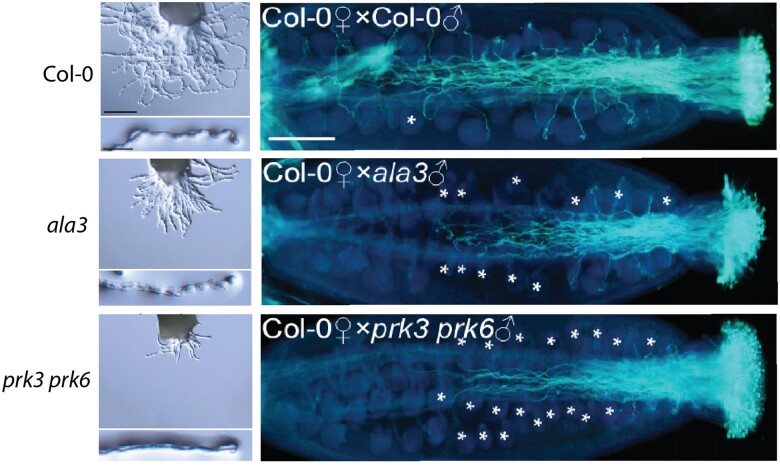Navigation devices have become an essential part of our lives. They help us get around unfamiliar terrain and we opt to rely on them rather than on our senses when the task at hand is important and the timing matters. During plant reproduction, efficient navigation is essential for the pollen tube to make its way through the transmitting tract, enter the micropyle to reach the female gametophyte, complete double fertilization, and produce seeds.
The pollen tube’s path is guided by a range of molecular attractants. These small signaling peptides are perceived by pollen-specific receptor-like kinases (PRKs), which activate signaling pathways required for the growth and steering of the pollen tube toward the female gametophyte. Members of the Arabidopsis PRK family are differentially distributed in the pollen tube plasma membrane. One apically localized homolog, PRK6, interacts with LURE1.2, a guiding peptide with species-specific preferences (Liu et al., 2021). In response to exogenous treatment with LURE1.2, PRK6 changes its distribution and localizes toward the LURE1.2 attractant (Takeuchi and Higashiyama, 2016). A new study by Yang and colleagues (Yang et al., 2022) investigates how this localization is regulated.
Previous research by the team found that ALA3, a type IV P-type ATPase that acts as a phospholipid flippase, sustains pollen tube growth and establishes the polar distribution of phosphatidyl serine (PS) (Zhou et al., 2020). In this study, Yang et al. (2022) demonstrated that defective pollen tube growth in ala3 mutants is accompanied by seed abortion and, as a result, lowered seed number in siliques. By performing reciprocal crossing and tracing pollen tube growth in vivo, the authors found that it takes ala3 pollen tubes twice as long as wild-type to reach the bottom of the pistil. The mutant pollen tubes showed a wandering phenotype and impaired ovule attraction sensitivity, indicating that guidance of the pollen tube through the transmitting tract and its entrance into the micropyle were perturbed. The guidance phenotype was fully restored in pALA3:ALA3-HA complemented lines, suggesting that the defects were due to the lack of the functional ALA3 gene.
Further dissecting the ala3-defective guidance phenotype, the authors found that the distribution of PRKs in pollen tubes was affected by the mutation. The abundance of PRK6, PRK3, and PRK1 was dramatically reduced in the apical membrane-proximal region and the apical plasma membrane. Zhou et al. (2020) previously demonstrated that ALA3 regulates the polar distribution of Rab GTPase RabA4d by establishing and maintaining the polar distribution of PS. Interestingly, the distribution of PRK6 was disturbed in raba4d mutants, highlighting the involvement of this GTPase in regulating PRK6 delivery to the correct locations in the pollen tube.
Having established a link between regulation of the PM phospholipid pattern and the distribution of PRKs, the authors used a lipid overlay assay with recombinantly expressed cytosolic domains of PRKs to test if PRKs can bind phospholipids. PRK3 and PRK6 showed a strong preference for PS and PA phospholipids (like most PRK family members), and PRK6 co-localized with the PS fluorescent reporter mCITRINE-C2Lact.
Interestingly, a prk3 prk6 double mutant displayed insensitivity to LURE1.2 attractant (see Figure, left). This finding fits the two PRKs into the ala3 “attractant-blind” phenotype puzzle. Disabling their interaction with phospholipids through mutations in the polybasic region, Yang and colleagues confirmed the essential role of the interaction in the correct localization of PRK3 and PRK6 (the most apically abundant PRKs) at the apex of the pollen tube. Moreover, the PRK–phospholipid interaction was necessary for PRK function since the mutated versions were unable to bind phospholipids and failed to rescue both the pollen tube growth and LURE1.2 insensitivity of prk3 prk6 double mutants.
Figure.
ALA3 and PRKs are required for efficient pollen tube growth and guidance in the pistil. Left: Semi-in vivo pollen tube growth/AtLURE1.2-responsive assay of Col-0, ala3, prk3 prk6. Scale bars: 100 μm (top) and 10 μm (bottom). Right: Aniline blue staining of Col-0, ala3, and prk3 prk6 pollen tubes growing into Col-0 pistils. The asterisks mark ovules that did not attract nearby pollen tubes. Scale bar: 100 μm. Adapted from Yang et al. (2022), Figure 5.
The study by Yang et al. (2022) thus solves another piece of the puzzle of pollen tube guidance. It reveals that by adjusting phospholipid abundance in the plasma membrane, ALA3 regulates the distribution of two pollen-specific receptor-like kinases, PRK3 and PRK6, thereby ensuring proper sensitivity to LURE1.2 attractant. What remains to be understood is how the delivery of PRKs is arranged, what brings ALA3 to its apical position, and how ALA3 activity is regulated.
References
- Liu C, Shen L, Xiao Y, Vyshedsky D, Peng C, Sun X, Liu Z, Cheng L, Zhang H, Han Z (2021) Pollen PCP-B peptides unlock a stigma peptide–receptor kinase gating mechanism for pollination. Science 372: 171–175 [DOI] [PubMed] [Google Scholar]
- Takeuchi H, Higashiyama T (2016) Tip-localized receptors control pollen tube growth and LURE sensing in Arabidopsis. Nature 531: 245–248 [DOI] [PubMed] [Google Scholar]
- Yang Y, Niu Y, Chen T, Zhang H, Zhang J, Qian D, Bi M, Fan Y, An L, Xiang Y (2022) The phospholipid flippase ALA3 regulates pollen tube growth and guidance in Arabidopsis. Plant Cell 34: 3718--3736 [DOI] [PMC free article] [PubMed] [Google Scholar]
- Zhou Y, Yang Y, Niu Y, Fan T, Qian D, Luo C, Shi Y, Li S, An L, Xiang Y (2020) The tip-localized phosphatidylserine established by Arabidopsis ALA3 is crucial for Rab GTPase-mediated vesicle trafficking and pollen tube growth. Plant Cell 32: 3170–3187 [DOI] [PMC free article] [PubMed] [Google Scholar]



